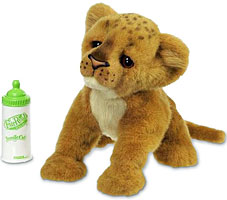Fur Real Friends Jungle Cats
Feedsee Toys : Fur Real Friends Jungle Cats : Furreal leopard and baby lion
 FurReal Jungle Cats can be a bit wild and rambunctious, but a little loving care will calm them down. Pet their backs to make them sit up and open their eyes, lie down or fall asleep. When these adorable cubs get too rowdy, gently tap them on the head and they'll respond with sheepish sounds. Lifelike plush robotic baby lion responds to your love and affection. When you pet the soft fur on your newborn cub, she will sit up, open her eyes, and make cute baby cub sounds. Keep petting her and your lion becomes more playful. But if you pet her too much, she might just get annoyed. Her sounds will let you know just what kind of mood she's in.
FurReal Jungle Cats can be a bit wild and rambunctious, but a little loving care will calm them down. Pet their backs to make them sit up and open their eyes, lie down or fall asleep. When these adorable cubs get too rowdy, gently tap them on the head and they'll respond with sheepish sounds. Lifelike plush robotic baby lion responds to your love and affection. When you pet the soft fur on your newborn cub, she will sit up, open her eyes, and make cute baby cub sounds. Keep petting her and your lion becomes more playful. But if you pet her too much, she might just get annoyed. Her sounds will let you know just what kind of mood she's in.
Evolution of Robotic Plush Animals
Robotic plush animals have come a long way since their inception, evolving from simple mechanical toys to sophisticated companions with advanced technological features. Here's a look at their journey:
- Early Beginnings: The initial robotic plush animals were basic in design, often featuring simple movements triggered by wind-up mechanisms or basic battery-operated systems.
- Sound Integration: As technology advanced, these toys began incorporating sound modules, allowing them to produce animal sounds or play melodies when activated.
- Interactive Features: The introduction of sensors enabled these plush animals to respond to touch, light, or sound. This interactivity made them more engaging for children, as they could react to petting, hugging, or external stimuli.
- Learning Capabilities: With the integration of more advanced electronics and software, some robotic plush animals gained the ability to "learn" from interactions, remember certain patterns, and even evolve their behavior over time.
- Connectivity: The rise of the internet and Bluetooth technology allowed these toys to connect to apps or online platforms, enhancing their functionality and interactivity. This connectivity also enabled software updates, expanding the toy's capabilities and lifespan.
- Emotion Simulation: Advanced models started to simulate emotions, using sensors and algorithms to react differently based on interactions, mimicking feelings like happiness, sadness, or excitement.
- Artificial Intelligence (AI): The latest generation of robotic plush animals incorporates AI, allowing them to engage in more complex interactions, recognize voice commands, and even exhibit distinct personalities.
Today, robotic plush animals are not just toys but companions that can provide comfort, entertainment, and even therapeutic benefits. Their evolution reflects the broader trend of integrating technology into traditional playthings, enhancing their appeal and functionality for modern users.